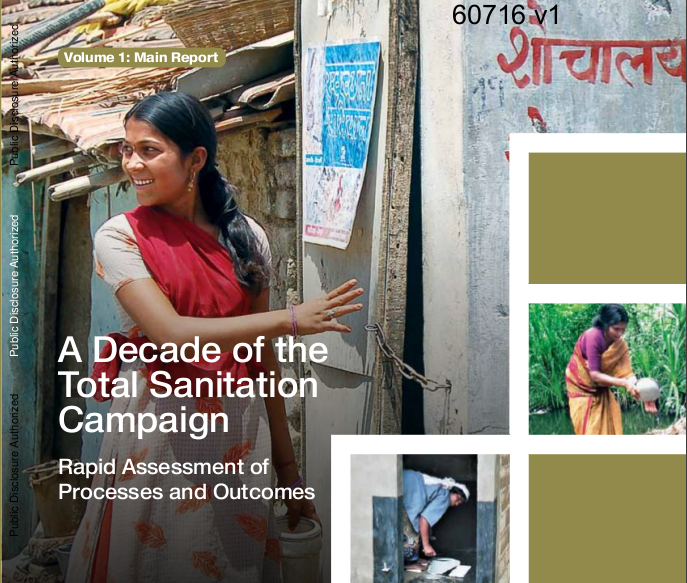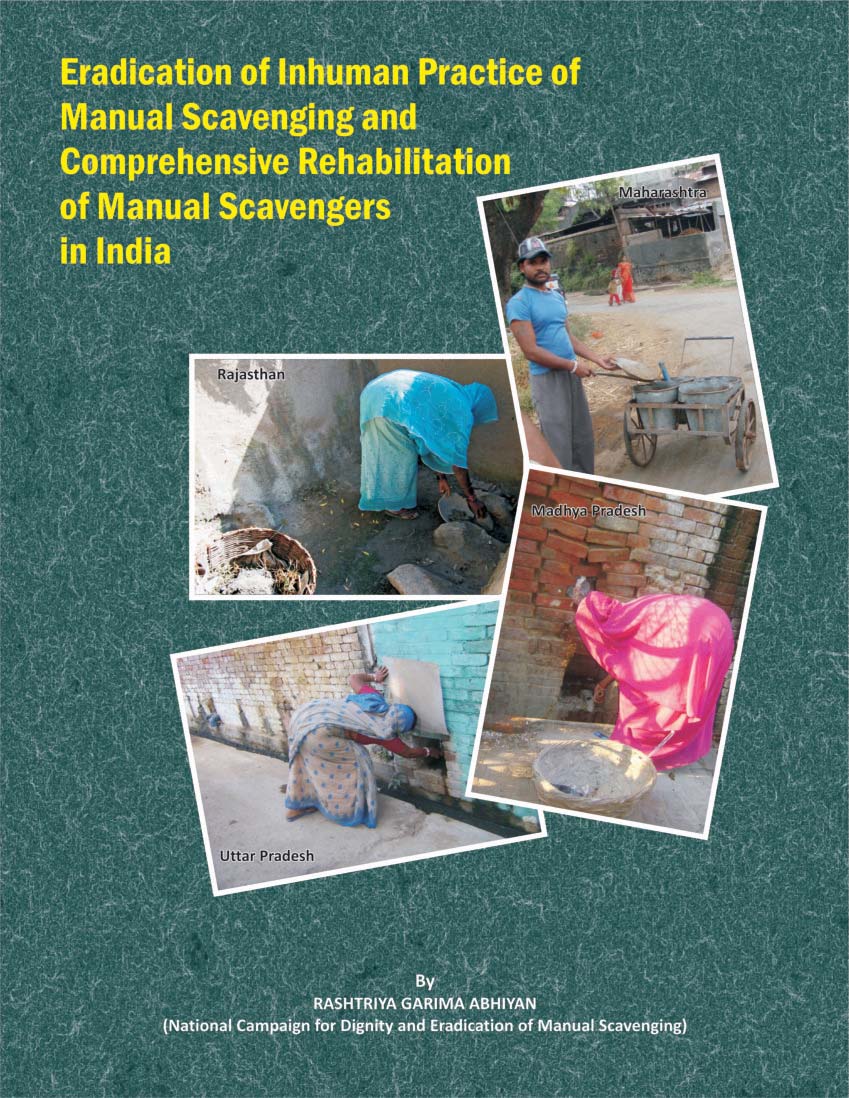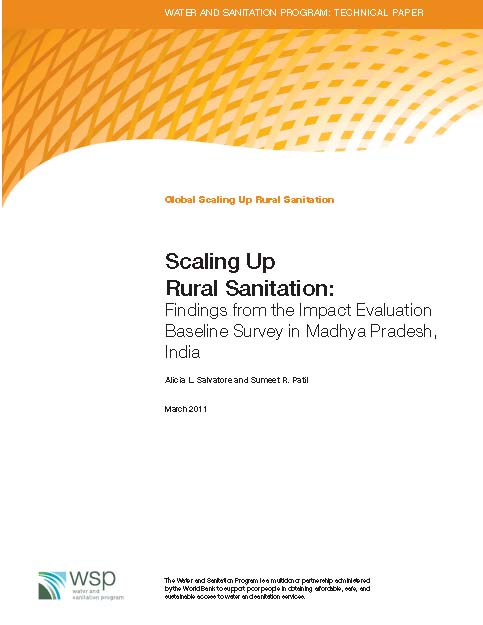/topics/sanitation-and-hygiene
Sanitation and Hygiene
A decade of the Total Sanitation Campaign - Rapid assessment of processes and outcomes: A report by the Water and Sanitation Program 2011
Posted on 22 Nov, 2014 10:30 AM The Water and Sanitation Program has analysed secondary data on the Total Sanitation Campaign (TSC) available on government websites and conducted primary analysis in 22 sample districts spread across 21 states.
The Water and Sanitation Program has analysed secondary data on the Total Sanitation Campaign (TSC) available on government websites and conducted primary analysis in 22 sample districts spread across 21 states.
With the use of secondary and primary data the report has not only been able to give a macro view of the TSC but also has been able to go into the nitty-gritty of the campaign. There are case studies of districts and villages that have achieved open defecation free status.
Eradication of inhuman practice of manual scavenging and comprehensive rehabilitation of manual scavengers in India A report by Rashtriya Garima Abhiyan
Posted on 22 Nov, 2014 10:30 AM The practice continues in the country in spite of efforts of several people, implementation of government schemes such as the National Scheme for Liberation and Rehabilitation of Scavengers since 1992 and Self Employment Scheme
The practice continues in the country in spite of efforts of several people, implementation of government schemes such as the National Scheme for Liberation and Rehabilitation of Scavengers since 1992 and Self Employment Scheme
Development of training module for water safety plan in urban areas A document by ESCI
Posted on 22 Nov, 2014 10:30 AMA Water Safety Plan (WSP) is an improved risk management tool designed to ensure the delivery of safe drinking water. It identifies hazards, means to control them, means and actions to identify loss of control and its restoration. It comprises system assessment and design, operational monitoring and management plans (including documentation and communication). Water quality guidelines have been issued by the WHO.
Guidelines for water safety plans for rural water supply systems A document by SIAES and WHO India 2009
Posted on 22 Nov, 2014 10:30 AM Delivery of safe drinking water is vital for protecting public health and of promoting more secure livelihoods.
Delivery of safe drinking water is vital for protecting public health and of promoting more secure livelihoods.
The traditional approach to water quality and safety management has relied on the testing of drinking water, as it leaves the treatment works or at selected points, either within the distribution system or at consumer taps. It is referred to as ‘end‐product testing’.
Application of Composite Correction Program for improvement in efficiency of water treatment plants A WHO paper
Posted on 22 Nov, 2014 10:30 AMThe goal of safe and affordable drinking water and sanitation has not yet been achieved. The current practices of water purification are inadequate to produce secured water supply. Maintaining health protection at water supply systems has become more challenging with resistance of some pathogens to disinfection using chlorination and an increase in the immuno-compromised population (e.g., people with HIV, organ transplant patients, the elderly).
In this context, it has become essential to develop various tools such as Composite Correction Programme (CCP) and Water Safety Plans (WSP) to improve water purification and distribution systems, to achieve the goal of providing safe drinking water.
Assessing acute Gastroenteritis risks associated with water quality and sanitation in Hyderabad city A paper by the Institute of Health Systems IHS
Posted on 22 Nov, 2014 10:30 AMThe quality of drinking water is a vital element of public health and well-being. The most effective means of consistently ensuring the safety of a drinking-water supply is through the use of a comprehensive risk assessment and risk management approach that encompasses all steps in water supply from catchment to consumer.
WHO guidelines on water quality term these approaches as water safety plans (WSPs), developed to organize, systematize and apply management practices in drinking-water quality.
Scaling up rural sanitation Findings from the impact evaluation baseline survey in Madhya Pradesh : A report by the Water and Sanitation Program of the World Bank
Posted on 22 Nov, 2014 10:30 AM This report by the Water and Sanitation Program (WSP) of the World Bank presents the findings of the baseline and community survey conducted in two districts of Madhya Pradesh (MP) - Dhar and Khargone. The goal of the program is to reduce the risk of diarrhea and therefore increase household productivity by stimulating demand for sanitation in the lives of people. The program also seeks to stimulate the supply of appropriate sanitation program and services by conducting market research and training local artisans to build the relevant facilities.
This report by the Water and Sanitation Program (WSP) of the World Bank presents the findings of the baseline and community survey conducted in two districts of Madhya Pradesh (MP) - Dhar and Khargone. The goal of the program is to reduce the risk of diarrhea and therefore increase household productivity by stimulating demand for sanitation in the lives of people. The program also seeks to stimulate the supply of appropriate sanitation program and services by conducting market research and training local artisans to build the relevant facilities.
In India, the program is supporting the Government of India’s (GoI) Total Sanitation Campaign (TSC) in two States: Himachal Pradesh and Madhya Pradesh. The main components of the intervention include: Community-Led Total Sanitation (CLTS), Social Marketing of Sanitation, Strengthening the Enabling Environment and Nirmal Gram Puraskar (NGP) Awards.
Role of civil society in sanitation improvement: A case study from the work of Parivartan in Uttar Pradesh 2010
Posted on 22 Nov, 2014 10:30 AMThis presentation prepared by the founders of Parivartan, a Kanpur based NGO, deals with the organisation's efforts to improve the sanitation system of the town by involving local citizenry.
Captain SC Tripathi, the founder of Parivartan explains that his organisation is based on a 'collective' model where in all aspects from ideation to implementation is a collective effort. This model seemed appropriate considering the different problems that Kanpur was facing ranging from sanitation issues to drainage, power outages etc. Added to this was political and official apathy, indifference and cynicism of citizenry.{C}
Tippy Tap A device to promote hand washing with soap Watershed Management Group
Posted on 22 Nov, 2014 10:30 AM





